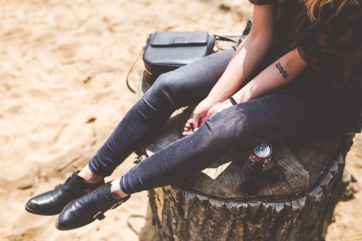Morning daydreamers and story tellers! I hope this week has been kind to you!
I have been thinking a lot about my characters this week; appreciating their quirks and, as I continue to edit my novel, fine tuning their traits. I am going to post a series of ‘creating characters’ posts over the next few months, and I have decided to start with physical traits first.
Physical traits include so much more than just the hair and eye colours of various characters in the story, and sometimes their physical traits can tell you plenty about their personalities. Here are some things to think about:
1. General traits (hair, eyes, build etc…)
I mentioned above that physical traits involve so much more than hair and eyes, but that doesn’t mean that these things aren’t important. Take Harry Potter, and the regular reference to his eyes being the same as his mothers. This link is always so important to him having a connection to his parents, and then made even more emotional during Snape’s final moments. Choosing the right hair style and colour, eye colour and physical build of a character could be really important to the story. Or it could simply be important to their personality. Even if these traits don’t impact your story in any way, you still need to consider them to build a picture of your character inside of your head.

2. The little things
When planning the above traits, think of the little things that can truly add authenticity to your story. Does your character’s beautifully straight hair curl at the ends in the rain or go static in the sun? Do their eyes darken when they’re tired? Little things can not only further aid to adding a touch of personality but make your characters more ‘3D’, not simply a straight forward image of blonde hair, blue eyes and nothing in between, for example.

3. Unique traits
Scars, tattoos, birth marks, smile lines…unique traits can be used to great potential in your story. Distinctive traits can be a problem for someone trying to hide, can be a badge of honour for someone with a story to tell. Unique traits separate your characters and are another way of adding more dimension to them. How did they get their scar? What do their tattoos represent? Physical traits don’t have to aid the story, but as long as they serve to enhance important aspects of your character’s personality, then they have a place in your writing.

4. Body language
When looking at a person, their body language could be the most important ‘physical’ trait when it comes to understanding their personality. Facial expressions, such as frowning, grimacing and lip biting can help build a wonderful mental image and convey emotion without actually mentioning the emotion directly (show, don’t tell and all that!). When creating characters consider the way they walk, the way they stand. A fun way to play with this is to picture them in various situations; at home on the sofa, in the middle of a party, on a busy platform at the train station, being interrogated by the police….even if these situations don’t have a place in your story it can still help you discover how your characters move and help you bring them to life.
Physical, subconscious action can also play a part; does your character run their fingers through their hair when they’re nervous? Do they scratch at their arms when they are frightened or bob on their toes when they’re happy?

5. Sense of style
What clothes do your character’s wear? What shoes? Playing around with style, be it clothing, piercings, hair cuts/colours and makeup is another fun way to create believable characters. Perhaps they are unique in style, or prefer to follow current trends. Perhaps they wear makeup because they LOVE red lipstick, perhaps they wear it to hide their insecurities.

Finding inspiration
Many writers enjoy people watching, be it sat at the window seat in a coffee shop, passing people in the streets or waiting at an airport. You can find inspiration for physical character traits and quirks everywhere you go. Look out for people with a unique sense of style, take note of the way people walk, sit and stand.
A lot of writers pick out actors who would play their characters in their ideal film adaptation. This doesn’t mean they describe their characters to look exactly like this person, but they make take some of their more subtle traits and apply them appropriately.
Write what you know! Isn’t that an expression we often hear (and often dispute!) In this case, however, it can be helpful. Throughout your life you have encountered hundreds of people. Everyone from your childhood best friend to your hairdresser has a physical appearance that could inspire you. Take parts you love about people, parts you hate, and use them to form characters who have personality oozing from them before you’ve even moved past their physical appearance.

How do you create your characters and their physical appearance? Do they simply come into your mind that way? Do you draw pictures, or combine images from magazines? I’d love to hear your thoughts, so please comment below!
Until then,
Keep writing,
M
x


I try to form a mental picture but it’s hard, so I figure out basic traits(face and little things as you said) and focus on them. Unique traits are important but not every character needs to have them. In the magical realism novel I’m writing my protagonist has a normal body with no significant distinction. The only thing maybe are her glasses, and her swarthy complexion which is rather uncommom in her area but a foreshadowing to her origins.
LikeLiked by 1 person
Great comment, thank you for sharing! Completely right that not every character needs a unique or unusual trait. But when it adds something to the story then it can be important. 🙂
LikeLiked by 1 person
Good comments. I don’t know if you’re familiar with the Percy Jackson books or not, but one of the characters named Annabeth was a pretty blond. A great many fans got upset when they did the movie and cast a brunette in the role. In some cases, that wouldn’t matter, but author Riordan had made her a blond for a specific reason that was important to her character. She was extremely intelligent and it bothered her when people wrote her off as a “dumb blond”. She felt like she had to work harder to prove herself, and be taken seriously. That whole aspect of her character got lost when they changed her hair color.
Something that simple can make a difference.
LikeLiked by 2 people
Thanks for sharing that comment, a valid point indeed! I always found, with the Harry Potter movies, that it didn’t bother me that Harry wasn’t presented with green eyes, I only wish they’d cast the young Lily Evans with the same kind of blue eyes as Dan Radcliffe, for the “you have your mothers eyes” to work. The actresses eyes were very dark brown, which seemed silly to me!
LikeLike
Great post, M, and I’m looking forward to reading the rest in the following months. I think you hit it spot on with the tip about making descriptions more than just eye and hair colour. I usually start with eye and hair colour, and let the story fill in the other details as I write until I have a fully formed character. I also like to give them distinctive clothing, for example, I have three female characters in my YA series. One always wears black, one wears jeans and fitted tee shirts or tank tops, and the other always dresses and cardigans. Just the clothing alone goes a long way toward their characterisation, so I totally agree with what you’ve written.
LikeLiked by 1 person
Thank you ❤ I love the way the story can enhance your idea on how they look, dress etc…and I love building character images in my head!
LikeLiked by 1 person
Great post. Description in one of my weaknesses. I usually favor action. I need to take a bit more time to show the “little things” as you suggest here. Thanks for the tips. 😀
LikeLiked by 1 person
I’m fairly weak on character descriptions, I think. I prefer to write about settings, actions, dialogue, reactions etc, but this is quite a helpful post in how to consider building in physical traits without being too obvious. Thanks 😊
LikeLiked by 1 person
Really interesting! Thank you
LikeLiked by 1 person